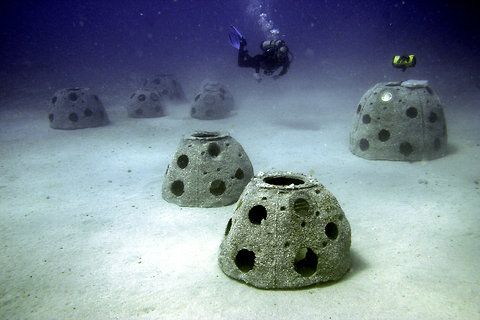 I couldn’t figure out how to delicately bring up the subject of what my parents want done with their bodily remains after death.
I couldn’t figure out how to delicately bring up the subject of what my parents want done with their bodily remains after death.
The topic is awkward on all sides. If you’re elderly, you may worry that just talking about what happens after death could be depressing or bad luck. (Is that wood-knocking I hear?) And if you’re the child of an elderly person, you don’t want it to look like you’re jumping the gun or already toting up your inheritance.
Recently, though, I came across some unusual options beyond the standard burial and cremation. And it struck me that saying something like, “Hey, Dad, did you hear we can turn your ashes into diamonds?” might be an excellent way to get the discussion rolling on how this final act should play out. I tried it.
I discovered that even though my folks purchased burial plots many years ago, they have now decided they want to be cremated. Go figure. I suggested they sell the plots and take themselves to a fancy dinner.
In the spirit of public service to caregivers and their loved ones, here’s a quick rundown of some alternatives to the traditional coffin burial. Discuss amongst yourselves.
Ashes to Dust to Diamonds
As it turns out, your cremated ashes can be made into jewelry for your family and friends to wear and remember you by. In a seven-step process, a company called Cremation Solutions will turn a few ounces of cremains into a diamond; depending on color and carat size, the cost runs anywhere from $2,500 to $25,000.
For $150, you can order a hand-blown glass pendant that holds a tiny portion of the ashes to “wear as a necklace or hang from your rear-view mirror,” the company says.
With the Fishes
Don Brawley got the idea for his company, Eternal Reefs, one day a few years back from his father-in-law, who was watching as Mr. Brawley dropped concrete balls in the sea around Florida to build up disappearing coral reefs.
“He said, ‘I want you to put my remains in those artificial reefs, so I can spend eternity with the grouper and the snapper,’” Mr. Brawley recalled. He did as his father-in-law asked, and continues to do for others, too.
Families can simply send the remains to Mr. Brawley to incorporate into the concrete balls, which he supplies free to seven state agencies to help rebuild reefs. Or relatives can get even more involved. One family placed a wedding ring in a concrete ball, along with a loved one’s ashes; another spelled out “I love you, Dad” with pebbles on the ball’s surface.
The balls can weigh 600 to 4,000 pounds, depending on how many people are included; the largest can handle a family of four. Costs range from about $2,995 to $6,995.
Cremation of a Different Kind
A new, eco-friendly version of cremation was first tried in Florida in 2010. Instead of fire, resomation, also known as bio-cremation, relies on mild heat, pressure and a water and alkali solution (potassium hydroxide) to dissolve bodily tissues into a clear, sterile liquid that advocates say can be safely poured down a drain. Metals from artificial joints, implants or fillings are recovered and disposed of, and then the bones are reduced to ash, just as it’s done with regular cremation, and returned to the family.
What’s so green about that? Resomation uses only one-seventh the electricity and gas involved in flame-based cremation. And it’s free of the mercury pollution from dental fillings and carbon dioxide emissions that are byproducts of the 1,800-degree Fahrenheit temperatures needed in conventional cremation.
There’s a catch. So far bio-cremation is legal in only eight states: Colorado, Florida, Illinois, Kansas, Maine, Maryland, Minnesota and Oregon. New York and New Jersey are considering it. And because this technique requires new machinery, it can be more expensive than regular cremation — from $1,000 on up.
Up and Away
Aching for one last adventure? For anywhere from $1,000 to $12,000 (not including the cost of cremation), Celestis Memorial Spaceflights will launch “a symbolic portion” of your loved one’s cremains (less than would fill half a lipstick tube) into earth orbit, onto the lunar surface, or into deep space. So far, ashes from 600 people have rocketed from Earth, but only one has gone to the moon. That was Eugene Shoemaker, who selected and trained Apollo astronauts in lunar geology.
A medical condition prevented him from following his first career choice as an astronaut. But on Jan. 6, 1998, he (one gram of him, at least) finally boarded NASA’s Lunar Prospector mission and made it to the moon.
Frozen in Time
Hoping to return to the mortal coil? You can arrange to freeze your body (or just your head — that’s cheaper) on the chance that in the future medical science might be able to bring you back. The cost for becoming a corpsicle: $28,000 to as much as $200,000.
Cryogenic freezing has been around for decades now. Some 200 bodies are said to be in storage in liquid nitrogen, and so far it has been a one-way trip for them. (Despite what you may have heard, Walt Disney is not among them. His death certificate shows that he was cremated and buried in California.)
Sustainable Burials
Concerned about burial space running out? If your body is sent to Australia,Upright Burials will bury you vertically to ensure you take up the least amount of space in a cemetery field that is kept in a natural state.
If you’re not willing to go that far, consider a host of green burial alternatives to save money and natural resources. Home funerals and even backyard burials were common in the United States into the 20th century, and they are still legal in most states. The nonprofit Green Burial Council offers a downloadable guide to help plan a green burial.
Why do it? Each year, according to the council, cemeteries nationwide bury more than 30 million board-feet of hardwood and 90,000 tons of steel in coffins, 17,000 tons of steel and copper in vaults, and 1.6 million tons of reinforced concrete in vaults, and more than 750,000 gallons of formaldehyde-laden embalming fluid.
Donate to Science
It’s not too late to get into show business. You can join the Body Worlds exhibit post-mortem and have yours become one of the see-through bodies frozen in action that tour the world, educating audiences about human anatomy. Thousands have already signed up to have their bodies undergo the plastination process, according to the Institute for Plastination in Heidelberg, Germany, which picks up the tab.
If the spotlight isn’t your thing, you can still donate your body to science and have the medical school of your choice pay the handling charges. The University of Florida State Anatomical Board has posted online contact information for medical schools that participate in whole-body donations.
Or simply flip over your driver’s license, sign the back and become an organ donor. Done!
